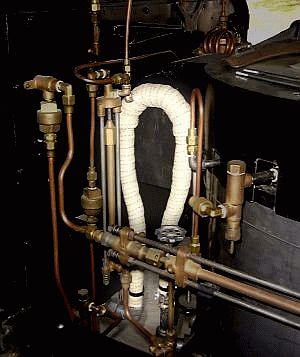As shown in the photograph above the steam loop is insulated
to limit the radiation of heat to the air. The complete steam line,
from the superheater under the boiler to the flexible coupling to the engine
is insulated. In addition the steam line between the throttle and the
superheater is insulated along with many of the other steam and hot water
lines associated with the car. The boiler is wrapped in a thick
blanket of insulation and the smokebox is also well insulated to contain the
boiler heat. The superheater ring and the side walls of the burner
contain high temperature insulation for heat control as well.
Original Stanley Steam cars relied on asbestos for
insulation of the boiler and steam piping. Today repairs are made with
"refractory ceramic fiber". This form of insulation is spun from Alumina (Al2O3)
and Silica (SiO2). It is available in
various forms including blankets, felt, and paper. Generally the blanket
form is used for insulating cavities such as the walls of the burner and the
smoke box. The felt can be used for the sides of the boiler while the paper
form provides a strong durable top covering to the outside surfaces of the
boiler. Pipes may be wrapped with various widths of ceramic fiber tapes and
some manufacturers offer ceramic fiber sleevings that can be slid over steam
tubing to insulate it. While there are numerous high temperature
adhesives available to secure insulation blankets and tapes in place, simple
heavy-duty wall paper paste works well, is inexpensive, and is what the
Stanley's used originally.
The blanket form of the insulation may be held in place by
the walls of the cavity it is used to fill such as the inner and outer steel
walls of the burner. The felt versions can be held in position with wire and
then a layer of the paper insulation applied to give a smooth surface.
Ceramic fiber paper can usually be dipped in water and then formed to the
surfaces is covers making it look like the original Stanley asbestos
insulation. Where it is necessary to secure the insulation in place and
provide a smooth surface, such as covering the exterior of the boiler, the
same methods used at the Stanley Factory may still be employed. Simply
coating the surface the insulation is to be adhered to with wall paper paste and then placing the
insulation in place is all that is needed. For sealing around the various
pipes at the top and bottom of the boiler the blanket material can be
shredded and mixed with wallpaper paste and then the resulting material
formed to fit the opening to be covered. For insulating steam pipes a roll
of ceramic fiber tape works well. The pipe can be coated with wallpaper
paste and then wrapped with a layer of the paper insulation. For extra
protection a layer of the braided or woven tape form of ceramic insulation
may be used similar to what is available for automotive exhaust headers.
The steam loop shown in the photograph is insulated with two layers of
1/8" thick by 1" wide ceramic fiber tape wrapped around the pipe and adhered
to the pipe with simple wall paper paste. An overall covering of a
woven tape similar to what is used on automotive exhaust headers has been
applied since the woven material provides better abrasion resistance and
durability than ceramic fiber tape.
There are numerous manufacturers of ceramic fiber insulation
products. One of the better-known manufacturers is Unifrax (
